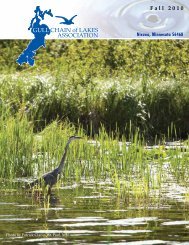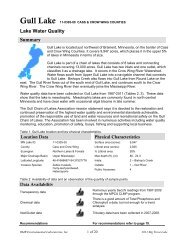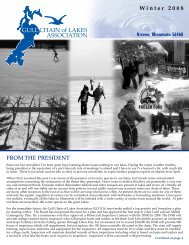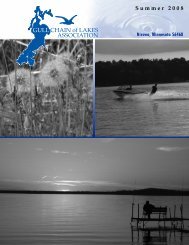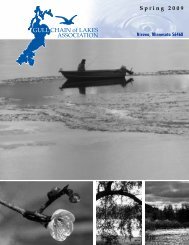Spring - Gull Chain of Lakes Association
Spring - Gull Chain of Lakes Association
Spring - Gull Chain of Lakes Association
Create successful ePaper yourself
Turn your PDF publications into a flip-book with our unique Google optimized e-Paper software.
DNR LAUNCHES NEW PREVENTION EFFORTS IN 2012<br />
TO SLOW SPREAD OF AQUATIC INVASIVE SPECIES<br />
(Released January 6, 2012)<br />
The Minnesota Department <strong>of</strong> Natural<br />
Resources (DNR) announced today its<br />
new strategies to fight the spread <strong>of</strong><br />
aquatic invasive species across the state<br />
in 2012.<br />
The efforts take a two-pronged<br />
approach: to increase inspections and<br />
decontamination <strong>of</strong> boats at and near<br />
water bodies, especially those infested<br />
with aquatic invasive species; and to<br />
increase awareness that the public must<br />
do its part not to spread invasive species.<br />
“The DNR cannot be at every boat<br />
ramp this summer, making sure boaters,<br />
anglers and other water users are not<br />
bringing zebra mussels and other<br />
invasive species to public waters,” said<br />
DNR Commissioner Tom Landwehr.<br />
“Our message is these waters belong to<br />
everyone – so everyone needs to be<br />
responsible for not moving these<br />
invaders.”<br />
In 2012, the DNR will institute new<br />
invasive species check stations, hire more<br />
watercraft inspectors, deploy more<br />
decontamination units and increase its<br />
public awareness efforts – all to stop the<br />
spread <strong>of</strong> zebra mussels and other<br />
aquatic invaders.<br />
Here is an overview:<br />
ROAD CHECK STATIONS<br />
A new state law gives DNR authority to<br />
operate check stations that require<br />
motorists transporting boats, trailers and<br />
other marine equipment to be inspected<br />
for aquatic invasive species.<br />
The check stations, which will begin this<br />
year, will route motorists pulling boats<br />
10<br />
or other marine equipment into staging<br />
areas, where they will be greeted, and a<br />
brief conversation will take place prior<br />
to their boats and other water-related<br />
equipment being inspected. Among<br />
other questions, inspectors will ask<br />
where the boat is coming from and how<br />
long it has been in the water.<br />
If the boat or water-related equipment<br />
fails the inspection, or inspectors believe<br />
the boat may be carrying aquatic<br />
invasive species, the motorist and boat<br />
water related equipment will be directed<br />
to an area where high-pressure and hot<br />
water will be used to decontaminate the<br />
equipment. Conservation <strong>of</strong>ficers may<br />
also take enforcement action if the<br />
motorist or boat owner has not<br />
Continued on page 11



